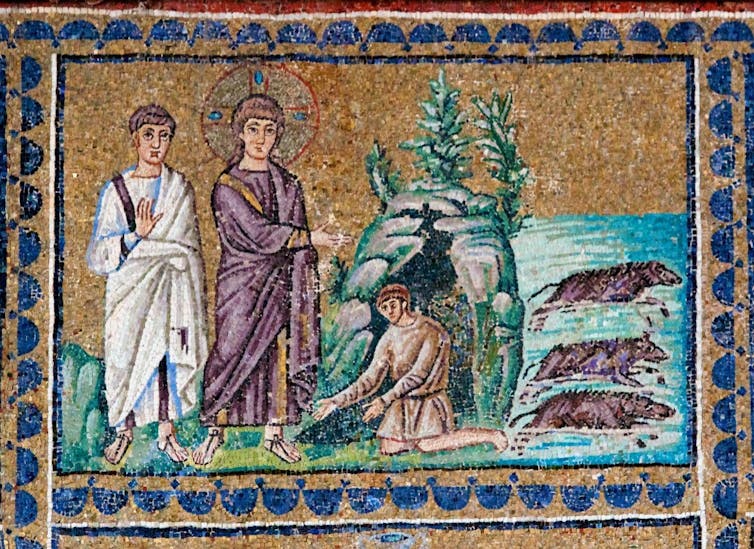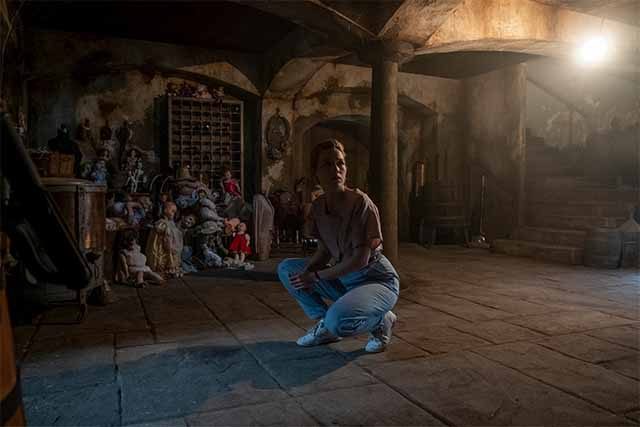Spoiler alert: this article explores some general plot trends from the series.
The clear standout among this Halloween season’s TV offerings is The Haunting of Bly Manor, a ghost story adapted from the Henry James novella The Turn of the Screw. In a strange twist for a TV series, the second episode features a conversation between Miles (a haunted orphan and one of the lead characters) and a priest about a biblical exorcism.
Young Miles worries about whether or not the Gerasene demoniac – a man on whom Jesus performed an exorcism, mentioned in the gospels of Mark, Matthew and Luke – allowed the legion of demons to possess him. The conversation gives us some insight into Miles’s world and foreshadows the plot twists to come.
But the story of the Gerasene demoniac speaks to a reality that is more terrifying than The Haunting of Bly Manor. He is, as I and others have argued before, one of a number of Biblical characters ostracised from society for what we might now call disabilities. Others include women with gynaecological problems and people suffering from leprosy.
According to the Bible, the possessed man had been repeatedly shackled and placed in isolation, away from his family, friends and the rest of his community. He lived in a cemetery, was chained up, naked and homeless.
Then they came to the other side of the sea, to the country of the Gadarenes.
And when He had come out of the boat, immediately there met Him out of the tombs a man with an unclean spirit,
who had his dwelling among the tombs; and no one could bind him, not even with chains,
because he had often been bound with shackles and chains. And the chains had been pulled apart by him, and the shackles broken in pieces; neither could anyone tame him.
And always, night and day, he was in the mountains and in the tombs, crying out and cutting himself with stones.
It is easy to assume that he was “bound with shackles and chains” because he was possessed – but the gospels do not supply us with a complete medical history. His ability to break free of restraints might as easily serve as a sign of his desperation as his supernatural power. We do not know whether or not the experience of being exiled to a cemetery had exacerbated whatever physical or psychological traits had led to his forcible exclusion from his community in the first place.
An important recent article by Boston University Bible scholar Luis Menéndez-Antuña explores how solitary confinement affects the wellbeing of those who are imprisoned and uses these experiences to reread the Bible story. Those placed in conditions similar to those of the demoniac, he writes, often experience extreme psychological side effects that “distort, undo, unhinge, and unglue subjectivity”.
Victims of this kind of social death feel detachment from their own bodies and identities, and even an inability to recall their own names. Convicted murderer Jack Abbott, who died in prison in 2002 but wrote letters describing the prison system and his experience of being confined to a blackout cell (a small room with no light), recalled:
I heard someone screaming far way and it was me. I fell against the wall, and as if it were a catapult, was hurled across the cell to the opposite wall. Back and forth I reeled, from the door to the walls, screaming. Insane.
Other former prisoners describe the experience of radical separation from human contact as “choking” them and trying to “squeeze sanity” from their mind.
Documented effects of solitary confinement include auditory and visual hallucinations, paranoia, PTSD, uncontrollable rage, self-harm and mutilation, diminished impulse control, and distortions of time and perception.
We are legion
This is precisely what we see with the Gerasene demoniac. He no longer identifies as himself and instead identifies himself as a legion of beings. The exorcism story, in which the demons are expelled from the man into a herd of pigs, is as much about reintegrating the man into society as it is about expelling evil forces. But what sociology and personal experiences tell us about the violent effects of the conditions in which he had been forced to live raises questions about how we should tell his story.

Mosaic from the Basilica of Sant’Apollinare Nuovo, Ravenna.
Whether or not we believe in the supernatural, we can ask whether the man’s condition was caused or exacerbated by members of his own family or community. Historically speaking, many people, including Jesus himself in Mark 3:20-25, have been accused of possession for their failure or inability to conform to certain social norms. We should not assume that all of the behavioral characteristics or torments the demoniac is experiencing when we meet him were present before his initial confinement.
As the coronavirus pandemic has shown us: isolation and loneliness are stressors for everyone, but especially for those with mental illness. The Gerasene demoniac experienced something much worse.
The realization that we do not know what role violent exclusion played in the possessed man’s condition raises questions about the ethics of some of our own practices when it comes to imprisonment. We should ask how certain punitive measures psychologically damage those who are incarcerated. Though it may seem as though we have come a long way from Bly Manor, we actually have not.
Over the course of the season, we learn that the primary evil character in the show became vengeful after being abandoned and confined alone for many decades. Even in the realm of fantasy, solitary confinement is psychological torture. It is of isolation and loneliness that we should truly be afraid.![]()
Candida Moss, Cadbury Professor of Theology, University of Birmingham. This article is republished from The Conversation under a Creative Commons license. Read the original article.










